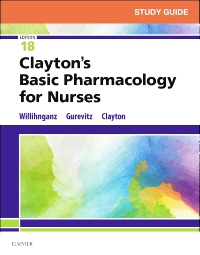
Study Guide for Clayton's Basic Pharmacology for Nurses - Elsevier eBook on VitalSource, 18th Edition
Elsevier eBook on VitalSource

Reinforce student understanding of nursing pharmacology! Corresponding to the chapters from the main text, the Study Guide for Clayton’s Basic Pharmacology for Nurses, 18th Edition provides students with additional practice to help them prepare for and succeed on the NCLEX®. Each exercise is linked to a chapter objective and various patient scenarios encourages students to use their knowledge of clinical pharmacology - further developing critical thinking skills. Plus, a wide range of question formats reflects the question types used on the latest NCLEX.
Newer Edition Available
Study Guide for Clayton's Basic Pharmacology for Nurses - Elsevier eBook on VitalSource
-
- NEW! Exercises and review questions correspond with updated content from the text.
- Additional question formats allow students to practice with the new question types found on the NCLEX® exam.
- Clinical patient scenarios help students develop critical thinking skills and apply their knowledge of nursing pharmacology.
- Medication administration handling and practice questions emphasized to reinforce safe medication administration practice.
-
- NEW! Exercises and review questions correspond with updated content from the text.
-
Unit 1: Applying Pharmacology to Nursing Practice 1. Drug Definitions, Standards, and Information Sources 2. Basic Principles of Drug Action and Drug Interactions 3. Drug Action Across the Life Span 4. The Nursing Process and Pharmacology 5. Patient Education to Promote Health
Unit 2: Illustrated Atlas of Medication Administration 6. Principles of Medication Administration and Medication Safety 7. Percutaneous Administration 8. Enteral Administration 9. Parenteral Administration: Safe Preparation of Parenteral Medications 10. Parenteral Administration: Intradermal, Subcutaneous, and Intramuscular Routes 11. Parenteral Administration: Intravenous Route
Unit 3: Drugs Affecting the Autonomic and Central Nervous Systems 12. Drugs Affecting the Autonomic Nervous System 13. Drugs Used for Sleep 14. Drugs Used for Neurodegenerative Disorders (NEW!) 15. Drugs Used for Anxiety Disorders 16. Drugs Used for Depressive and Bipolar Disorders 17. Drugs Used for Psychoses 18. Drugs Used for Seizure Disorders 19. Drugs Used for Pain Management
Unit 4: Drugs Affecting the Cardiovascular System 20. Introduction to Cardiovascular Disease and Metabolic Syndrome 21. Drugs Used to Treat Dyslipidemias 22. Drugs Used to Treat Hypertension 23. Drugs Used to Treat Dysrhythmias 24. Drugs Used to Treat Angina Pectoris 25. Drugs Used to Treat Peripheral Vascular Disease 26. Drugs Used to Treat Thromboembolic Disorders 27. Drugs Used to Treat Heart Failure 28. Drugs Used for Diuresis
Unit 5: Drugs Affecting the Respiratory System 29. Drugs Used to Treat Upper Respiratory Disease 30. Drugs Used to Treat Lower Respiratory Disease
Unit 6: Drugs Affecting the Digestive System 31. Drugs Used to Treat Oral Disorders 32. Drugs Used to Treat Gastroesophageal Reflux and Peptic Ulcer Disease 33. Drugs Used to Treat Nausea and Vomiting 34. Drugs Used to Treat Constipation and Diarrhea
Unit 7: Drugs That Affect the Endocrine System 35. Drugs Used to Treat Diabetes Mellitus 36. Drugs Used to Treat Thyroid Disease 37. Corticosteroids 38. Gonadal Hormones
Unit 8: Drugs Affecting the Reproductive System 39. Drugs Used in Obstetrics 40. Drugs Used in Men’s and Women’s Health
Unit 9: Drugs Affecting Other Body Systems 41. Drugs Used to Treat Disorders of the Urinary System 42. Drugs Used to Treat Glaucoma and Other Eye Disorders 43. Drugs Used to Treat Cancer 44. Drugs Used to Treat the Musculoskeletal System 45. Drugs Used to Treat Infection
Unit 10: Drugs Affecting the General Health of the Body 46. Nutrition 47. Herbal and Dietary Supplemental Therapy 48. Substance Abuse

